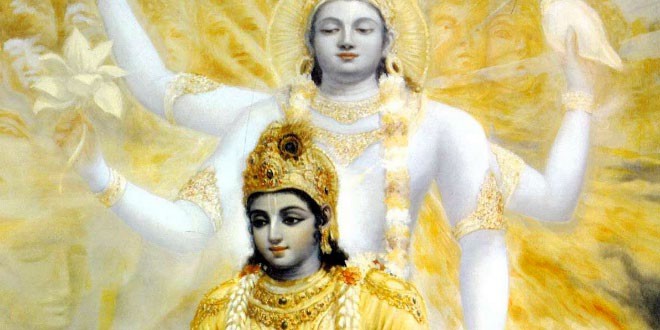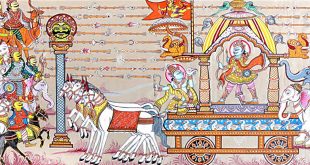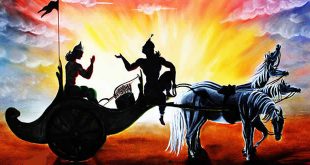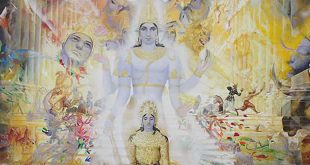Jnana Yoga-Bhagavad Gita Chapter 4 [Approaching the Ultimate Truth]
Krishna Said > Shaloka: 8
![Jnana Yoga-Bhagavad Gita [Chapter: 4 - Verse 8]](https://www.4to40.com/wp-content/uploads/2015/01/4_shaloka_08.gif)
English
In order to deliver the pious and to annihilate the miscreants, as well as to reestablish the principles of religion, I advent Myself millennium after millennium.
Purport
According to Bhagavad-gita, a sadhu (holy man) is a man in Krishna consciousness. A person may appear to be irreligious, but if he has the qualifications of Krishna consciousness wholly and fully, he is to be understood to be a sadhu. And duskrtam applies to one who doesn’t care for Krishna consciousness. Such miscreants, or duskrtam, are described as foolish and the lowest of mankind, even though they may be decorated with mundane education; whereas another person, who is one hundred percent engaged in Krishna consciousness, is accepted as sadhu, even though such a person may neither be learned nor well cultured. As far as the atheistic are concerned, it is not necessary for the Supreme Lord to appear as He is to destroy them, as He did with the demons Ravana and Kamsa. The Lord has many agents who are quite competent to vanquish demons. But the Lord especially descends to appease His unalloyed devotees, who are always harassed by the demoniac. The demon harasses the devotee, even though the latter may happen to be his kin. Although Prahlada Maharaja was the son of Hiranyakasipu, he was nonetheless persecuted by his father; although Devaki, the mother of Krishna, was the sister of Kamsa, she and her husband Vasudeva were persecuted only because Krishna was to be born of them. So Lord Krishna appeared primarily to deliver Devaki, rather than kill Kamsa, but both were performed simultaneously. Therefore it is said here that to deliver the devotee and vanquish the demon miscreants, the Lord appears in different incarnations.
In the Caitanya-caritamrta of Krishnadasa Kaviraja, the following verses summarize these principles of incarnation:
srsti-hetu yei murti prapance avatare
sei isvara-murti ‘avatara’ nama dhare
mayatita paravyome sabara avasthana
visve avatari’ dhare ‘avatara’ nama
“The avatara, or incarnation of Godhead, descends from the kingdom of God for material manifestation. And the particular form of the Personality of Godhead who so descends is called an incarnation, or avatara. Such incarnations are situated in the spiritual world, the kingdom of God. When they descend to the material creation, they assume the name avatara.“
There are various kinds of avataras, such as purusavataras, gunavataras, lilavataras, sakty-avesa avataras, manvantara-avataras and yugavataras–all appearing on schedule all over the universe. But Lord Krishna is the primeval Lord, the fountainhead of all avataras. Lord Sri Krishna descends for the specific purposes of mitigating the anxieties of the pure devotees, who are very anxious to see Him in His original Vrndavana pastimes. Therefore, the prime purpose of the Krishna avatara is to satisfy His unalloyed devotees.
The Lord says that He incarnates Himself in every millennium. This indicates that He incarnates also in the age of Kali. As stated in the Srimad-Bhagavatam, the incarnation in the age of Kali is Lord Caitanya Mahaprabhu, who spread the worship of Krishna by the sankirtana movement (congregational chanting of the holy names), and spread Krishna consciousness throughout India. He predicted that this culture of sankirtana would be broadcast all over the world, from town to town and village to village. Lord Caitanya as the incarnation of Krishna, the Personality of Godhead, is described secretly but not directly in the confidential parts of the revealed scriptures, such as the Upanisads, Mahabharata, Bhagavatam, etc. The devotees of Lord Krishna are much attracted by the sankirtana movement of Lord Caitanya. This avatara of the Lord does not kill the miscreants, but delivers them by the causeless mercy of the Lord.
Hindi
![Jnana Yoga-Bhagavad Gita [Chapter: 4 - Verse 8]](https://www.4to40.com/wp-content/uploads/2015/01/4_shaloka_08_hindi.gif)
Punjabi
![Jnana Yoga-Bhagavad Gita [Chapter: 4 - Verse 8]](https://www.4to40.com/wp-content/uploads/2015/01/4_shaloka_08_punjabi.gif)
Gujarati
![Jnana Yoga-Bhagavad Gita [Chapter: 4 - Verse 8]](https://www.4to40.com/wp-content/uploads/2015/01/4_shaloka_08_gujarati.gif)
 Kids Portal For Parents India Kids Network
Kids Portal For Parents India Kids Network




